Eel monitoring 2013
There’s lots more information on eels, and the things being done to help them, in our article published in 2013, so make sure to have a read of that too. We’ve also added some new links to the ‘Further Reading’ section which includes articles about eels, eel conservation, eel legislation and other eel projects:
The ZSL eel monitoring in the Thames 2013
Eel monitoring 2014
In 2013 I had the opportunity to get involved in the ZSL eel monitoring in the Thames project. Having developed something of a love affair with eels I’ve since been involved in a habitat improvement project close to the eel trap site in the Hogsmill river, and have signed myself up again for the 2014 round of trap checking. Last year wasn’t a great result for me as I didn’t find any eels during my checks, so I’m hoping to improve on my score this year! In August 2013 ZSL installed eel tiles in a section of the Hogsmill near to where it flows into the Thames. The young eels which are heading from the sea and into the rivers are not especially strong swimmers and find it hard to get past concrete river beds with a shallow water level. The eels are good at wriggling though, and the tiles help them gain purchase on slippery concrete and give them a helping hand onto the next section of river. The Kingston University biodiversity blog has more info on all the projects and work undertaken so check it out for more news and information:
Kingston University biodiversity blog
Positive signs for Critically Endangered European eel: Jo Barker, ZSL’s Europe and UK Programme Co-ordinator explains more about eels
httpss://www.youtube.com/watch?v=e9wg6TErkgI
Eel training (for me, not the eels!)
I returned to Joe Pecorelli’s training session on 14th of May 2014 to brush up on knowledge, tips and tricks for this year’s monitoring. Joe’s enthusiasm and love of eels is an infectious as ever and he came armed with a World Fish Migration Day placard for our group photo.
ZSL is hosting an eel awareness day at the aquarium to celebrate World Fish Migration Day with various activities including a Totaliser (readers of a certain age will recall the famous Blue Peter totalisers on children’s television in the UK!) showing a live update of eel catch in the traps on WFMD. Personally I think they’ve missed a trick by not calling it the TotEeliser but I’m sure this won’t detract from it!
ZSLMarine posted a photo of the story so far on WFMD, 24th May 2014 at about 15.30 UK time, and it even features a pic of Team Hogsmill (third down on the left)!:
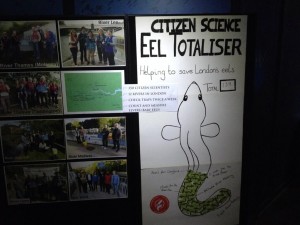
Why eels?
Someone asked me recently “why eels?”. For me there are several reasons; they’re local to me and I feel it’s important to conserve the environment on your doorstep as this is so easily overlooked in favour of more exotic and better publicised conservation. They’re an iconic part of London culture to the degree that few people actually realise that they are critically endangered. London and jellied eels go together like pie ‘n’ mash and there is little awareness of the fact that if their decline isn’t halted then London will just have to make do with jellied jelly instead. They’re an integral part of the food chain (even without jelly!) and their disappearance would have a huge knock on effect on other species.
They have a ridiculously dramatic and complex life cycle which involves so much more effort than other species have to go to, eels really like to do it in style. They travel thousands of miles as tiny creatures at the mercy of the ocean’s currents and predators, they navigate from saltwater to freshwater through complicated and heavily engineered waterways to get to their long term homes, undergoing several morphs as they do so as they grow and develop. They then spend ten to twenty years living it up (and avoiding predators, fishermen and getting sucked into power-stations’ water supplies) before embarking on their final one way trip back to the Sargasso Sea thousands of miles away. During this trip they morph again, their underbellies go silver so predators underneath them struggle to see them, their backs go dark so that predators above them struggle to see them. It’s recently been discovered that they can survive at depths of up to 1000 metres, a depth that would kill a human just by the pressure alone.
Eel reveals its migration secrets
This page on the BBC shows a great illustration of what you can find at various depths in the oceans, as well as information on the conditions at those depths:
Ocean trench: Take a dive 11,000m down
Their migration is remarkable. The baby eels coming back to Europe from the Sargasso Sea could end up anywhere the currents take them, they can’t swim well enough to choose where they want to go. So they have no say in whether they end up in England, Ireland, mainland Europe. But yet somehow, twenty years later, they set off for the Sargasso Sea and know exactly where they’re going.
Once they arrive in the Sargasso Sea they spawn. They never return from the sea and it’s thought that they die after spawning. If you’ve go to go, you might as well do it in style in one last hoorah near Florida! A species that goes to this much effort during its lifetime deserves recognition and support. They’re not just a fish, they’re so much more. They might not be fluffy and cuddly but they’re just as deserving of conservation, research and support as those that are.
A lovely cartoon by Ted Prosek from the TED Ed channel on Youtube featuring Eli the Eel explains the eels’ lives in more detail
The Kingston University trap checking
The Kingston University group is hopeful of improving on last year’s score of seven. Three of these turned up at the same time before the tiles were laid, and the others arrived on three different days afterwards. It’s hoped that the eel tiles, and the habitat improvement work that’s been done, will encourage more eels to consider the Hogsmill for their long term home from now on. Eels have been reported arriving in large numbers earlier in the season so with any luck the ocean currents will have been kind to the UK:
The great eel migration: One million to swim to Britain in one night
Trap checking has started in earnest and as if on cue, and in (almost!) perfect time for a starring role in World Fish Migration Day, the first eel was caught on Tuesday 20th May! The lucky eel wrangler was none other than Peter, my comrade in a zero catch check last summer. The season has kicked off successfully so we wait with crossed fingers for the next trap check. I’ll be updating throughout the season so watch this space for more eel action!
Here’s a photo, and a video, of a really quite feisty little eel!
Click this link for a video clip of first eel of the season © Peter Knight
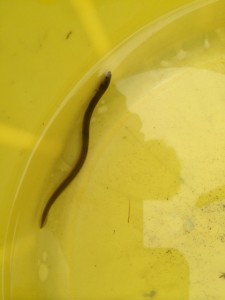
June 2014
Toby Hull, Catchment Project Officer from the South East Rivers Trust, has updated the SERT website blog with some detailed information on further work undertaken in the Hogsmill recently. An eel pass has been installed on another weir downstream of the one with the trap. This should ease the eels’ passage considerably and help them navigate the weir and carry on upstream. This is good news for the Middle Mill trap checkers as it gives us more chance than ever of finding eels in our trap.
SERT website blog
2nd of June provided more eely action when Laurence struck aquatic gold and found two more eels in the trap, bringing this year’s tally up to three. As per last year’s routine, any eels found in the trap are measured and the number of eels, plus their sizes are reported back to ZSL via their website. Putting them in bags might look a bit mean but it’s only for a few seconds and keeps the eels much safer than trying to hold a tiny wiggly slippery slimy creature against a ruler by hand. Baby eels are remarkably cute really, I mean, just look at those little eyes and tiny fins!
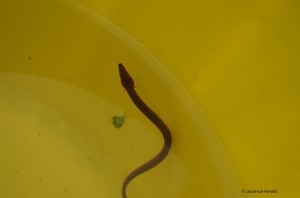
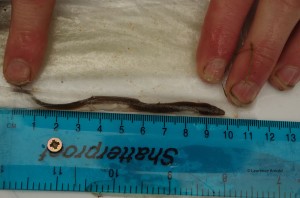
10th June saw my first trap check of the season, I met up with fellow Kingston University staff member Kathy and headed to Middle Mill with our fingers firmly crossed. Sadly, despite a thorough rootle in the trap and general poke about through the bits and pieces we couldn’t convince ourselves that there were any eels in there.
Friday 13th June and I met up with the effervescent Nigel who’s busy making the most of his retirement and engaging in all manner of conservation activities. We were optimistic as ever, but braced for disappointment as the weather had been particularly hot and sunny the last few days and the water levels in the river were quite low. Again, despite Nigel’s best efforts at sifting through the debris in the trap there was not an eel in sight.
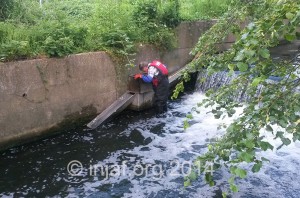
We remain hopeful for further finds, and I have a few more checks scheduled in so you never know, I might meet my first eel yet.
July 2014
Friday 4th July saw me meeting up with Ian for another trip to the trap. Ian usually helps with the traps at Teddington Lock but was curious to see another site so we arranged to meet for a check at Middle Mill. I can only assume that the eels were busy celebrating American Independence Day in honour of their American eel cousins, Anguilla rostrata, as there wasn’t a single Anguilla anguilla to be seen! Still, we took the opportunity to give the trap a good clean out and get rid of some of the mulm and debris lurking at the bottom so we felt we’d been some use.
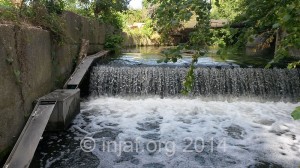
Monday 28th July brought some interesting news when Sivi, Kingston University’s Biodiversity Administrator, went to check the trap and ensure the brushes and bristles were clean and in working order – a 50cm long adult eel popped out from underneath the trap and high tailed it away downstream! It’s good to see that adults are at least entering the Hogsmill to investigate its potential as a home.
As well as the one outside the trap, which are not required to be reported to ZSL, there was another, smaller one, in the trap. This is number four, so not a bad result for the season so far. A moment in a bag for safety while measuring and Number 4 was sent on its way upstream.
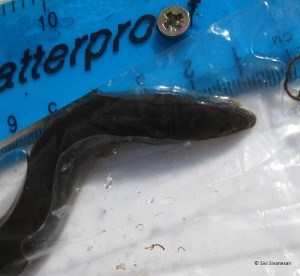

August 2014
Friday 8th August and once again hope was in the air as I met up with Rachel and Kathy for another visit to the trap. During the summer holiday weeks there are three people on the check rota just in case someone has to drop out. There are less staff and students around the university during the summer so it’s not so easy to find someone to take your place. However, we had a full ensemble on Friday and were also joined by Kathy’s son who was intrigued as to his mother’s secret double life as an eel whisperer and wanted to see what she was getting up to! Rachel found eels during last season’s checking, and Kathy’s son volunteered to act as a lucky mascot, so we hoped Lady Luck might smile on us. Sadly she didn’t, not in the form of bringing eels anyway. Runner beans now, that was a different matter! A nice man from the community allotments on the other bank gave Kathy a big bunch of beans while she was investigating the trap! So again, no eels but not a wasted trip either.
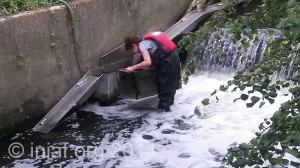
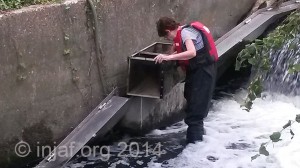

19th August and a breaking news email came through from the university’s Biodiversity Administrator – five eels were found in the trap today! This takes the total tally for 2014 to nine which exceeds last year’s numbers and the season isn’t over yet. In the grand scheme of things, nine eels in one river is a terrible result, there should be far, far more. But as far as the Hogsmill is concerned it’s great news. This is a heavily engineered river with various barriers to migration haunting it, but the work of the ZSL team, the South East Rivers Trust and all the volunteers is appearing to be paying off as the numbers increase even very slightly.
The lucky winner of the Famous Five was Nigel, my trap check comrade from 13th June. I was curious as to why four were in one bucket, and one in another. It turns out number five had been lying low when the trap was removed from the water and had evaded capture. It was only when the trap was on the verge of going back in that the elusive fellow was spotted and popped in the bucket!
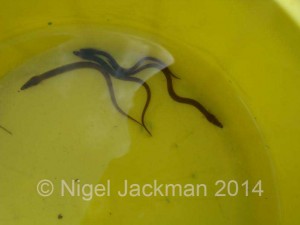

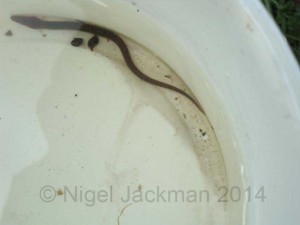
September 2014
The end of the checking season is drawing close and I’ve STILL not actually seen one of these mythical eels for myself! I teamed up with Nigel the Eel Whisperer today and hoped that his run of luck would continue in my presence. The eels clearly felt that enough was enough though and refused to make an appearance. I did have one brief moment of hope but it turned out to be a soggy stick that had gone floppy in the water!
For all those, like me, who’ve never managed to meet an eel face to face here’s a rather lovely video filmed in the lower Itchen river by Jack Perks for the Beneath the Waterline Project.
Author: Suzanne Constance
Photos courtesy of Peter Knight, Laurence Arnold, NIgel Jackman and Sivi Sivanesan. Eel film courtesy of Jack Perks‘ Beneath the Waterline Project, many thanks to Jack for letting us use the film for this article.
Beneath the Waterline
The Beneath the Waterline Project is a film project by nature photographer Jack Perks. The aim is to film all fifty-four of the UK’s native freshwater fish species to highlight the issues and problems they face, what’s being done to help them, and to raise awareness of tricky to see native species. For more information check out the following pages, you can also follow the project on Facebook:
Beneath the Waterline Project
Jack Perks Photography
UK mini fish study Facebook page
Further reading
There are lots of articles and further reading in our article from 2013, we’ve decided to try and keep all the further reading in one place rather than a bit here and a bit there, so check out the 2013 article for more information.




